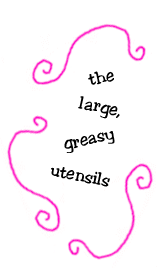 This week’s selection is from a high school home economics book, but I don’t think I had to wait that long to learn how to do this fairly common childhood chore. My mom had me scraping and scrubbing dishes at a much younger age! For those of you still a bit clueless about this particular household task, here are some tips from How You Plan and Prepare Meals. It was written by experts Byrta Carson and MaRue Carson Ramee.
This week’s selection is from a high school home economics book, but I don’t think I had to wait that long to learn how to do this fairly common childhood chore. My mom had me scraping and scrubbing dishes at a much younger age! For those of you still a bit clueless about this particular household task, here are some tips from How You Plan and Prepare Meals. It was written by experts Byrta Carson and MaRue Carson Ramee.
1962: Washing the Dishes
![]() Preparing to Wash Dishes
Preparing to Wash Dishes
Scrape and rinse the dishes that are especially soiled. Soak in cold water dishes that contained cereal, egg, or flour mixtures. Soak in hot water greasy dishes and those that were used for sugar mixtures.
If the pans or skillets are badly burned, fill them with water. Add a little baking soda, and boil them until clean.
Stack the dishes by putting similar things together. Place the glasses next to the sink since they should be washed first. Place the silverware next and then the china. Pots, pans, and other utensils should be last. Smaller and least-soiled cooking utensils should be placed so that they will be washed before the large, greasy utensils.
Washing the Dishes
1. Fill the sink or the dishpan half full with hot soapy water. The amount of soap or detergent that you should use depends upon the hardness of the water.
2. Put only a few dishes into the sink or the dishpan at one time.
3. Hold each dish in your left hand and the sponge or the dishcloth in your right hand as you wash dishes.
4. Rinse the dishes with plenty of very hot water. Glasses, cups, jars, and bottles should be rinsed inside and out. Plates, saucers, and so on, should be rinsed on both sides.
5. Place the dishes in the dish drainer at an angle at which they will drain best. For example, turn glasses and cups upside down after they have been scalded. Stand plates, saucers, and so on, at almost a right angle.
6. Dry the dishes with a clean dish towel, and put them in their proper places.
7. Hang up the dish towel neatly when you finish drying the dishes.
8. Pour the dishwater through a sink strainer unless you have a garbage disposal. Otherwise you may clog the sink.
9. Use soapy water to clean the sink, rubbing it hard. If the sink is especially dirty, use soda or a fine scouring powder. Use a bleach to remove stains.
10. Clean the table and the cabinet tops thoroughly, giving special attention to the edge of the table. Any food left on the table or in cracks is apt to attract insects.![]()
Source: Carson, Byrta, and MaRue Carson Ramee. How You Plan and Prepare Meals. St. Louis, Mo.: Webster Division, McGraw-Hill Book Co., 1962.
~ pp. 402-403 ~